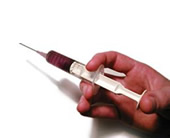-
Bosscher Foundation Live!
The new website is finally live Bosscher Foundation.Read more...
History of local anesthetics
The first people, as far as we know, with knowledge of local anesthesia were the inhabitants of Peru. They had long known that chewing on coca leaves caused a numbing of the mucous membrane in the mouth. It was not until the latter half of the 19th century that research into this effect was conducted in Europe. This lead to the first eye operation under local anesthesia by the eye surgeon, Kol Ier in Vienna in 1884. The anesthesia was achieved using cocaine. Following this first successful operation cocaine was increasingly administered as a local anesthetic. In fact cocaine became commonplace in Europe as a local anesthetic. Before long, the disadvantages of cocaine became self-evident. Toxicity, a short lasting effect and addiction were problematic. However, the local anesthesia phenomenon had become well known and greatly appreciated.
It was not until the latter half of the 19th century that research into this effect was conducted in Europe. This lead to the first eye operation under local anesthesia by the eye surgeon, Kol Ier in Vienna in 1884. The anesthesia was achieved using cocaine. Following this first successful operation cocaine was increasingly administered as a local anesthetic. In fact cocaine became commonplace in Europe as a local anesthetic. Before long, the disadvantages of cocaine became self-evident. Toxicity, a short lasting effect and addiction were problematic. However, the local anesthesia phenomenon had become well known and greatly appreciated. It was now possible to carry out an operation without causing the patient unnecessary suffering, the doctor was better able to concentrate on the procedure in hand and the affliction could be treated much sooner because the threshold for both doctor and patient to start treatment had become much lower.
A need arose however to find alternatives for cocaine as a local anesthetic due to the negative side effects of cocaine usage. An alternative appeared in 1905 in the form of Procaine. It was marketed under the name Novocaine™ and remained the most important local anesthetic until the 1940's. Novocaine™ was and is (it is still being sold) an ester-type anesthetic. It is a cocaine derivative, meaning that it is chemically related to cocaine, with similar characteristics, but without the toxicity, with a longer lasting effect and without the problems of addiction. Novocaine™ is a substance that breaks down in the bloodstream and thereby causes the formation of certain by-products, which can cause an allergic reaction. This is just one of the disadvantages of this and other ester-type local anesthetics.
The issue of hypersensitivity reactions attributed to ester-type anesthetics (cocaine derivatives) contributed to their demise and prompted the search for new substances with less chances of allergic reactions.
A new substance, lidocaine was first developed in 1943 and marketed in 1947 under the name, Xylocaine™. It was the first amide-type local anesthetic, meaning that it was broken down in the liver rather than in the bloodstream. Breaking down such substances in the liver as opposed to in the bloodstream is advantageous, since little or no by-products are formed, which can cause allergic reactions. Lidocaine is generally well tolerated by patients, is mildly toxic, has a sufficiently long lasting effect and is non-addictive. The only disadvantage of lidocaine is that it is slow in taking effect. The use of this substance by the dentist is recognizable when the patient is asked to back to the waiting room for a while to allow the anesthesia to take effect (approx. 10 - 15 minutes).
 Before long, lidocaine became the most widely used anesthetic in dental practices. That lasted, however, until the introduction of prilocaine at the end of the 50's. Prilocaine is one of the weaker but less toxic local anesthetics. One particularly annoying characteristic of prilocaine is that it sometimes is not, or barely, effective. We deduce from reports received that this effect may have something to do with inflammatory reactions in the body. Prilocaine seems to be more sensitive than other local anesthetics. We reserve judgment on this issue pending further information. Prilocaine is marketed under the trade name, Citanest™.
Before long, lidocaine became the most widely used anesthetic in dental practices. That lasted, however, until the introduction of prilocaine at the end of the 50's. Prilocaine is one of the weaker but less toxic local anesthetics. One particularly annoying characteristic of prilocaine is that it sometimes is not, or barely, effective. We deduce from reports received that this effect may have something to do with inflammatory reactions in the body. Prilocaine seems to be more sensitive than other local anesthetics. We reserve judgment on this issue pending further information. Prilocaine is marketed under the trade name, Citanest™.In 1976, articaine was developed and marketed under the trade name Ultracain™ by Hoechst A.G. and shortly thereafter, under the name Septanest™ by the French pharmaceutical company, Septodont S.A. This last product has the same characteristics as Ultracain™. In 1983 Ultracain™ was approved for the Dutch market. In this time, it is estimated that Ultracain™ and Septanest™ have jointly attained a 40 - 45% share of the market.
Scince then, Scandonest™ has also been approved as a local anesthetic for dental use. The active component in Scandotest™ is scandicaine. Scandicaine is a substance originally used in regional anesthesia (epidural anesthesia) and developed into a local anesthetic, which as far as we know has no negative side effects. This substance does not use a vasoconstrictor and as such does not need any preservative. In some instances, preservatives are undoubtedly the cause of allergic reactions (see "The Active Components in Local Anesthetics").

 NL
NL  EN
EN  DE
DE 
